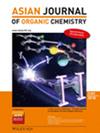氧烷驱动的5-芳基烷-噻唑烷-2,4-二酮的级联转化
IF 2.8
4区 化学
Q1 CHEMISTRY, ORGANIC
引用次数: 0
摘要
研究了噻唑烷-2,4-二酮(TZDs)与氧环烷的反应。首次观察到5-芳基烯- tzd衍生物可以转化为6-取代的1,4-草酸-2- 1。此外,某些3-取代5-芳基烯- tzds在与氧烷反应后可转化为1,4-草酸-2- 1和恶唑烷,证实了该过程遵循级联机制。影响反应结果的因素有几个,包括氧烷的量、碱的存在和溶剂极性。已经确定二甲基甲酰胺(DMF)是有效进行反应所必需的。此外,还证实了苄基在促进反应中的关键作用。通过核磁共振光谱观察到,苯基的邻氢和噻唑烷环上的硫原子之间存在一个不寻常的氢键,突出了硫原子的强电子接受性质,这在观察到的转化中起着关键作用。本文章由计算机程序翻译,如有差异,请以英文原文为准。
Oxirane‐Driven Cascade Transformations of 5‐Arylidene‐Thiazolidine‐2,4‐Diones
The reaction of thiazolidine‐2,4‐diones (TZDs) with oxiranes has been thoroughly investigated. For the first time, it has been observed that 5‐arylidene‐TZD derivatives can undergo transformation into 6‐substituted 1,4‐oxathian‐2‐ones. Additionally, it has been demonstrated that certain 3‐substituted 5‐arylidene‐TZDs can convert to 1,4‐oxathian‐2‐ones and oxazolidines upon reaction with oxiranes, confirming that the process follows a cascade mechanism. Several factors have been found to influence the reaction‘s outcome, including the amount of oxirane, the presence of a base, and solvent polarity. It has been determined that dimethylformamide (DMF) is essential for the reaction to proceed efficiently. Furthermore, the critical role of the benzylidene group in facilitating the reaction has been confirmed. An unusual hydrogen bond between the ortho‐hydrogens of the phenyl group and the sulfur atom of the thiazolidine ring, observed via NMR spectroscopy, highlights the sulfur atom‘s strong electron‐accepting properties, which play a key role in the observed transformations.
求助全文
通过发布文献求助,成功后即可免费获取论文全文。
去求助
来源期刊

Asian Journal of Organic Chemistry
CHEMISTRY, ORGANIC-
CiteScore
4.70
自引率
3.70%
发文量
372
期刊介绍:
Organic chemistry is the fundamental science that stands at the heart of chemistry, biology, and materials science. Research in these areas is vigorous and truly international, with three major regions making almost equal contributions: America, Europe and Asia. Asia now has its own top international organic chemistry journal—the Asian Journal of Organic Chemistry (AsianJOC)
The AsianJOC is designed to be a top-ranked international research journal and publishes primary research as well as critical secondary information from authors across the world. The journal covers organic chemistry in its entirety. Authors and readers come from academia, the chemical industry, and government laboratories.
 求助内容:
求助内容: 应助结果提醒方式:
应助结果提醒方式:


